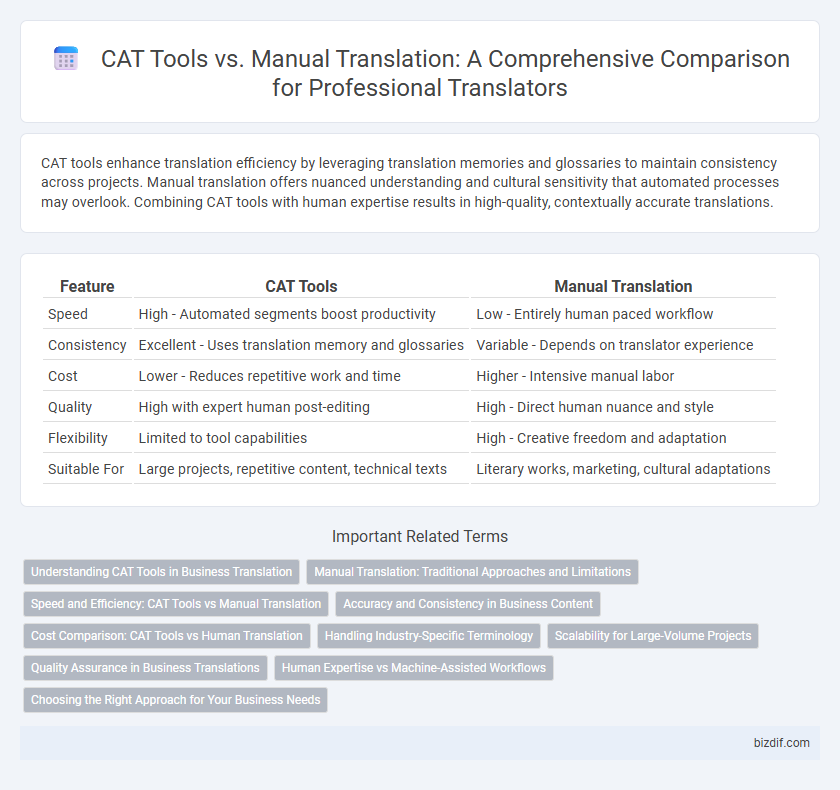CAT tools enhance translation efficiency by leveraging translation memories and glossaries to maintain consistency across projects. Manual translation offers nuanced understanding and cultural sensitivity that automated processes may overlook. Combining CAT tools with human expertise results in high-quality, contextually accurate translations.
Table of Comparison
| Feature | CAT Tools | Manual Translation |
|---|---|---|
| Speed | High - Automated segments boost productivity | Low - Entirely human paced workflow |
| Consistency | Excellent - Uses translation memory and glossaries | Variable - Depends on translator experience |
| Cost | Lower - Reduces repetitive work and time | Higher - Intensive manual labor |
| Quality | High with expert human post-editing | High - Direct human nuance and style |
| Flexibility | Limited to tool capabilities | High - Creative freedom and adaptation |
| Suitable For | Large projects, repetitive content, technical texts | Literary works, marketing, cultural adaptations |
Understanding CAT Tools in Business Translation
CAT tools enhance business translation by increasing consistency, efficiency, and accuracy through the use of translation memory and terminology management. Unlike manual translation, CAT tools leverage software to store previously translated segments, reducing redundancy and ensuring uniformity across large projects. Implementing CAT tools in business translation workflows streamlines collaboration and accelerates turnaround times, directly impacting cost-effectiveness and quality control.
Manual Translation: Traditional Approaches and Limitations
Manual translation relies heavily on human expertise to interpret and convey meaning between languages, ensuring cultural nuances and context are preserved. This traditional approach, however, is time-consuming and prone to inconsistencies due to varying translator skills and fatigue. Unlike CAT tools, manual translation lacks automation features such as real-time terminology management and translation memory, which can limit efficiency and scalability for large projects.
Speed and Efficiency: CAT Tools vs Manual Translation
CAT tools significantly increase translation speed by leveraging translation memories and automated terminology databases, enabling rapid reuse of previously translated content with consistent quality. Manual translation, while flexible, often requires more time due to the lack of automation and the need for extensive linguistic analysis in every segment. Efficiency in CAT tools reduces project turnaround times and lowers costs, making them ideal for large-volume or repetitive translation tasks.
Accuracy and Consistency in Business Content
CAT tools enhance accuracy and consistency in business content by leveraging translation memory and terminology databases that reduce human errors and ensure uniform language use across documents. Manual translation, while flexible, often struggles with maintaining consistent terminology and style, especially in large projects or revisions. Integrating CAT tools streamlines workflows, delivering precise, standardized translations crucial for brand integrity and regulatory compliance.
Cost Comparison: CAT Tools vs Human Translation
CAT tools significantly reduce translation costs by automating repetitive tasks and leveraging translation memory databases, enabling faster project completion and lower hourly rates. Manual translation involves higher expenses due to the need for extensive human labor, nuanced language understanding, and quality control processes. The cost-efficiency of CAT tools is most evident in large-scale or repetitive projects where consistent terminology and reduced turnaround times are critical.
Handling Industry-Specific Terminology
CAT tools efficiently manage industry-specific terminology by leveraging translation memories and terminology databases, ensuring consistency and accuracy across large projects. Manual translation relies heavily on the translator's expertise and reference materials, which can lead to variability in terminology usage. Specialized CAT tools incorporate customizable glossaries tailored to industries such as legal, medical, and technical fields, optimizing precision and workflow speed.
Scalability for Large-Volume Projects
CAT tools enhance scalability in large-volume translation projects by automating repetitive tasks and managing translation memories, which significantly reduces turnaround time. Manual translation lacks consistent speed and can cause delays as project size grows due to increased human effort and fatigue. Integration of CAT tools also ensures consistent terminology across extensive content, improving quality while handling scalability demands efficiently.
Quality Assurance in Business Translations
CAT tools enhance quality assurance in business translations by providing consistency through translation memory and terminology management, reducing human errors, and accelerating review processes. Manual translation relies heavily on the translator's expertise and thorough proofreading but may lack the systematic error checking and consistency CAT tools offer. Businesses prioritizing accuracy and efficiency often integrate CAT tools to ensure high-quality translations aligned with industry standards.
Human Expertise vs Machine-Assisted Workflows
Human expertise in translation ensures nuanced understanding of cultural context, idiomatic expressions, and industry-specific terminology, which machines often overlook. CAT tools enhance productivity by offering translation memory and terminology management, allowing translators to maintain consistency and speed without sacrificing quality. Combining human insight with machine-assisted workflows results in more accurate, contextually appropriate, and efficient translations.
Choosing the Right Approach for Your Business Needs
Selecting the appropriate translation method depends on project complexity, volume, and desired accuracy. CAT tools enhance consistency and efficiency by leveraging translation memories and terminology databases, ideal for large-scale or repetitive content. Manual translation offers nuanced understanding and cultural adaptation, making it preferable for creative or specialized texts requiring high linguistic precision.
CAT Tools vs Manual Translation Infographic

 bizdif.com
bizdif.com